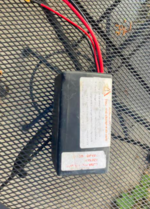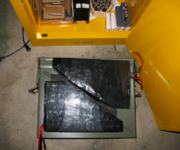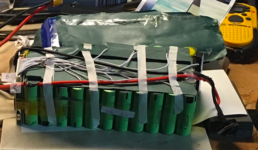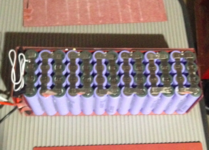You are using an out of date browser. It may not display this or other websites correctly.
You should upgrade or use an alternative browser.
You should upgrade or use an alternative browser.
Batteries on winter rides
- Thread starter idbugyou
- Start date
indianajo
Well-Known Member
I used about twice normal watthours on a 22 mile ride at 42 deg F. Charging battery at freezing or below damages them. I take the battery off my bike and keep it either under a heat pad or in non-freezing storage from the beginning of freezing temperatures until late April at least. I pedal the bike unpowered all winter. Since it is a geared hub motor, there is no motor drag. I rode today 8 mi RT to & from grocery, unpowered. Takes about 30 minutes to take the battery off, and 20-30 to put it back on again. Battery is intentionally difficult to remove to prevent theft.
idbugyou
New Member
- Region
- USA
I actually charge my battery on the bike inside my houseI used about twice normal watthours on a 22 mile ride at 42 deg F. Charging battery at freezing or below damages them. I take the battery off my bike and keep it either under a heat pad or in non-freezing storage from the beginning of freezing temperatures until late April at least. I pedal the bike unpowered. Since it is a geared hub motor, there is no motor drag. I rode today 8 mi RT to & from grocery, unpowered.
harryS
Well-Known Member
When I ride the same route in cold weather, the battery will have sat in the garage all night, so it's at ambient. I'll use about the same power, but the battery loses more voltage putting it out. Energy conservation says I'll have to put in corresponding more current to recharge it again.
6zfshdb
Well-Known Member
- Region
- USA
- City
- Northeast Pennsylvania
I keep my batteries in heated storage until just before going out to ride. At 40 degrees or so, riding continuously at a moderate pace without lengthy stops, I notice a 10 to 20% loss of battery capacity. As previously stated, the battery generates heat when discharged, which partially offsets the thermal degradation.
There are thermal covers for many battery types which can help.
There are thermal covers for many battery types which can help.
fauconnier
Active Member
- Region
- Canada
Good infos:

 batteryuniversity.com
batteryuniversity.com

 batteryuniversity.com
batteryuniversity.com

 batteryuniversity.com
batteryuniversity.com

 batteryuniversity.com
batteryuniversity.com

BU-410: Charging at High and Low Temperatures
Batteries operate over a wide temperature range, but this does not give permission to also charge them at these conditions. Extreme cold and high heat…

BU-809: How to Maximize Runtime
One battery user writes, “Hi, I am looking for an answer to a perplexing question. Moving into a new house, she complained that her battery life has…

BU-502: Discharging at High and Low Temperatures
The dry solid polymer battery requires a temperature of 60–100°C (140–212°F) to promote ion flow and become conductive. If, for example, a battery…

Learn About Batteries
Battery University™ is a free educational website offering hands-on battery information.
Last edited:
AHicks
Well-Known Member
- Region
- USA
- City
- Snow Bird - Summer S.E. Michigan, Winter Gulf Coast North Central Fl.
Even down here in Florida it can get cold enough (40f or below) where you will notice reduced capacity if you know your bike. Thankfully days like that are unusual, but it does happen.
fooferdoggie
Well-Known Member
there spare battery we carry on our tandem is what's really going to suffer.
tomjasz
Well-Known Member
- Region
- USA
- City
- Minnesnowta
Horse pucky.This is because battery use generates heat.
PedalUma
Well-Known Member
- Region
- USA
- City
- Petaluma, CA
Last year some people in Canada were talking on EBR about battery covers when they go out on frozen rides. So, I took the idea and ran with it, making the Gatorade battery cover as a joke.


One problem with big swings in temperature is the expansion and contraction of air and the condensation of humidity. Motors are not dive watches. They breath a little when they heat up and then get cold. This air can bring moisture with it which condenses inside things like displays, controllers, and motors. One guy was thawing his bike each morning with a pan of hot water to remove the ice. That destroyed his Specialized commuter bike. He did get a warrantee motor but it took a long time.
One problem with big swings in temperature is the expansion and contraction of air and the condensation of humidity. Motors are not dive watches. They breath a little when they heat up and then get cold. This air can bring moisture with it which condenses inside things like displays, controllers, and motors. One guy was thawing his bike each morning with a pan of hot water to remove the ice. That destroyed his Specialized commuter bike. He did get a warrantee motor but it took a long time.
6zfshdb
Well-Known Member
- Region
- USA
- City
- Northeast Pennsylvania
Batteries can be different in this respect. At the end of a ride, the battery in my bike is always warm to the touch. Perhaps this isn't the case with all others.Horse pucky.A well designed battery appropriately sized will NOT generate heat. My bikes all have temperature readings and I ride all winter in Minnesota.
An internet search will yield many articles, such as this one, that describe the thermal characteristics of lithium batteries:
Thermal Behavior Analysis of Lithium Ion Cells used in EVs and HEVs
The batteries for electric vehicles (EV) generate heat during discharging cycles. During these rapid discharge cycles the temperature of cell may increase above allowable limits. The high temperature of lithium ion cell is the primary factor affecting the cell performance and life. To develop effici
My DeWalt lithium cordless tool batteries for example always get hot after use. The pair in my cordless lawn mower are almost too hot to touch. The charger has a temperature sensor which will not start the charge until the battery temp drops to room temperature.
Battery heat generation is a complicated subject with no right or wrong answer. It all depends on the individual battery and how it's used. The chemical process during charge and discharge cycles does generate heat. Batteries however can be designed to dissipate this heat and minimize temperature rise.
tomjasz
Well-Known Member
- Region
- USA
- City
- Minnesnowta
The only batteries I’ve had that shed significant heat are the low P packs. My Luna 52v, small pack got hot pulling 30A with a BBSHD. But 15A could be pulled with little if any r was l temp rise. I apologize for the lacking details. I’m old it’s late and bill mahr is on.
Believe what you want. The science doesn't change because of your beliefs. As I already said, the heat generation is dependent on the discharge rate. Riding on the level with little assist is different from climbing a long steep hill with maximum assist. When might you find a noticeable temperature rise? It depends on a lot of factors, including battery design, housing, BMS and load.Horse pucky.A well designed battery appropriately sized will NOT generate heat. My bikes all have temperature readings and I ride all winter in Minnesota.
AHicks
Well-Known Member
- Region
- USA
- City
- Snow Bird - Summer S.E. Michigan, Winter Gulf Coast North Central Fl.
Load being the key word here. Many (most) of us are using very lightly loaded batteries for our bikes. Case material can have a lot to do with heat as well. For instance, an alum. clad pack can dissipate heat very quickly/easily. Common sense would tell us when touching a case like that would be difficult to feel temp build up in anything but extreme cases.Believe what you want. The science doesn't change because of your beliefs. As I already said, the heat generation is dependent on the discharge rate. Riding on the level with little assist is different from climbing a long steep hill with maximum assist. When might you find a noticeable temperature rise? It depends on a lot of factors, including battery design, housing, BMS and load.
Bottom line, I'm not planning on internal heat build up as much of a factor in any of the riding I do.....
tomjasz
Well-Known Member
- Region
- USA
- City
- Minnesnowta
I believe my temperature sensors. With an undersized Luna 52V 6Ah pack I saw lots of heat generated. Same cells in a 20Ah triangle pack, very little heat produced pulling 30A.Believe what you want.
I've addled my way through a dozen or more personal battery packs repairs, builds and upgrades. A properly sized battery will not shed enough heat to keep a pack warm below zero Celsius.
A few of the monitored batteries I've owned and used in Minnesota winters.
Attachments
-
 Screen Shot 2021-11-25 at 11.53.11 AM.png493 KB · Views: 255
Screen Shot 2021-11-25 at 11.53.11 AM.png493 KB · Views: 255 -
 Screen Shot 2021-11-25 at 11.53.26 AM.png454.3 KB · Views: 238
Screen Shot 2021-11-25 at 11.53.26 AM.png454.3 KB · Views: 238 -
 Screen Shot 2021-11-25 at 11.54.19 AM.png688.8 KB · Views: 258
Screen Shot 2021-11-25 at 11.54.19 AM.png688.8 KB · Views: 258 -
 Screen Shot 2021-11-25 at 11.56.40 AM.png544.1 KB · Views: 322
Screen Shot 2021-11-25 at 11.56.40 AM.png544.1 KB · Views: 322 -
 Screen Shot 2021-11-25 at 11.57.32 AM.png590.7 KB · Views: 257
Screen Shot 2021-11-25 at 11.57.32 AM.png590.7 KB · Views: 257 -
 Screen Shot 2021-11-25 at 11.58.37 AM.png779.2 KB · Views: 248
Screen Shot 2021-11-25 at 11.58.37 AM.png779.2 KB · Views: 248
tomjasz
Well-Known Member
- Region
- USA
- City
- Minnesnowta
We're actually in agreement after re reading. But I'll reiterate. An adequately designed battery with increased parallel cells will generate very little heat. 52V 14S2P trashed in a matter of months running BBSHD @ 30A 1500W. My 14S6P shed very little heat. Certainly NOT enough for a 20 mile ride in below freezing temps to keep the battery from sagging due to cold temps.Believe what you want. The science doesn't change because of your beliefs. As I already said, the heat generation is dependent on the discharge rate. Riding on the level with little assist is different from climbing a long steep hill with maximum assist. When might you find a noticeable temperature rise? It depends on a lot of factors, including battery design, housing, BMS and load.
fauconnier
Active Member
- Region
- Canada
At a low discharge rate of 0.5C, the temperature is constant. It's probably what my wife and I do most of the time on a 2 hours ride, draining the battery to approx. 3.8v per cell. As an example one of my bike a MTB has a 17.5 Ah battery and my controller is limited to 25A, the maximum possible discharge rate being near 1.4C, the maximum temperature increase should be a couple of deg.C for A1 battery and approx. 8 deg.C for battery C1 for the first 80%. The difference between A1 and C1 certainly come from the discharge rate, C rating, of the two 18650 tested. IMHO a few deg.C rise during maximal use, like draining the battery in 45 minutes at ambiant temp, is not even enough to heat the pack to make a difference in range in cold weather.

Last edited:
Similar threads
- Replies
- 6
- Views
- 4K
- Replies
- 33
- Views
- 7K
- Replies
- 7
- Views
- 3K
- Replies
- 54
- Views
- 3K